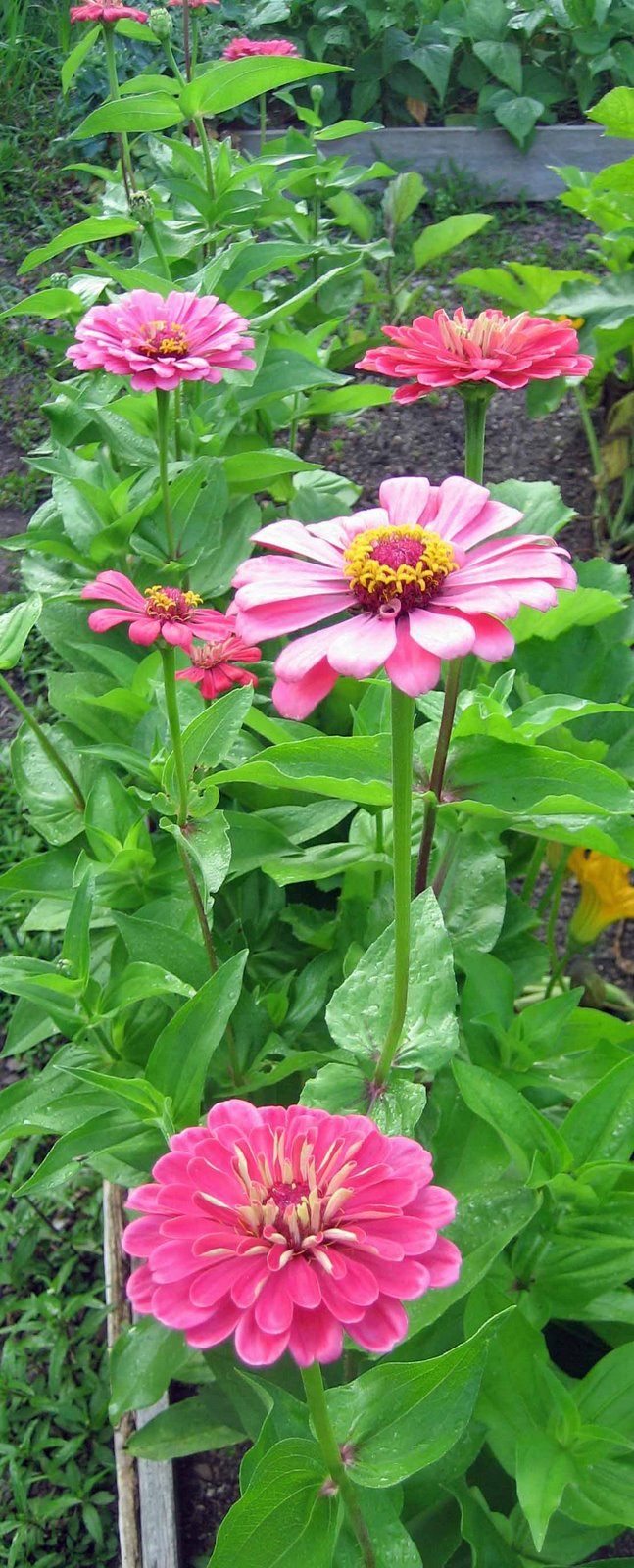 When Zinnias start blooming on and on
When Zinnias start blooming on and on
Hurrah! Hurrah!
We’ll know that summer is here for sure
Hurrah! Hurrah!
The flowers will bloom, the gardeners will smile
The bees they will be all about
And we’ll all be happy when Zinnias start blooming on and on.
Look at that nice straight row of Zinnias. Have you ever seen such precision planting?
That’s why a march like “When Johnny Comes Marching Home Again” came to mind when I looked at those Zinnias. Feel free to sing the words above to that tune as you gaze upon that nice straight row.
For some reason, as I’ve noted before, I often find myself planting in straight rows. It’s not like I use a yardstick to make the rows straight… wait, check that, I have used a yardstick to make my rows straight. But usually just in the vegetable garden where nice, straight rows make it easier to harvest some vegetables like beans and lettuce.
Yet, in some of my flower beds, you might look at the plant placement and think that to decide where to put a plant, I turned my back to the flower bed, tossed a trowel over my shoulder, and then planted wherever the trowel landed.
Figuring out the right placement for a plant in the garden is both an art and a science.
The ‘science’ part is picking a location with the right amount of sunlight or shade, appropriate drainage, the right soil type, and room for the plant to grow, both horizontally and vertically.
The ‘art’ part is picking a location that is part of an overall planting design, that allows the plant to play off other plants in that garden bed, to be showy when it is in bloom, but then blend into the background when other plants are blooming.
I’m still figuring out plant placement, not so much the science part, but the art part. I try to avoid straight lines, but it takes some work on my part. And sometimes a few months after I plant something, it just looks wrong, so I move it. And we know moving plants multiple times doesn’t help them grow.
I think I should find a basic landscape design class for gardeners and sign up or find a good book on garden design and study it. Any suggestions? Maybe a garden design book would be a good selection for the Garden Bloggers’ Book Club?
I did read in the local paper about some gardens in northern Indiana that have lots of straight lines. Local gardeners there planted several flower beds to resemble quilt squares. I ought to drive up to northern Indiana and see those quilts.
Or, maybe I can give in to my straight-line planting ways by planting a knot garden in my backyard, something like these gardens at White River Gardens?



There does seem to be an art to plant placement. In some of my beds I can see it in my head before I planted and in others I can’t seem to find a starting point.
Seeing it before I plant is not easy for me! Sometimes in it goes after I do that dance you describe so well…then it gets moved to another spot later…I wish I could visualize it better.
I like a little bit of symmetry and a little bit of surprise in the garden. 🙂 Your zinnias are beauties — love them for their bright colors and perfect blooms. 🙂
i suspect it’s your orderly mind that makes you plant in rows. To compensate you could always try the “toss and plant” strategy. Just toss them and plant them where they land. Of course, that works better for some plants than others. It’s great for bulbs.
Robin
Gardening Examiner
Hey, if you've got it (the innate ability to plant in straight rows) then flaunt it (with a knot garden) right?!! 🙂
But if you do decide to choose a garden design book for the GB Book Club, I highly recommend the one by Stephanie Cohen and Nan Ondra. I'll admit, I was put off a bit by the hot pink cover, but there's a great amount of information there. The one on designing Beds & Borders from Fine Gardening is nice, too.
Plant placement is art & science, but sometimes it's beyond my control. I can't plant things exactly where I want them sometimes because there's a tree root in the way, or a stump, or some other impediment. You do have a choice to make: embrace your straight lines & make that part of the design, or try to fight your natural tendencies. The book that taught me the most about plant placement is the grandaddy of them all, Gertrude Jeckyll's "Color Schemes for the Flower Garden." She's the originator of the idea of planting in "drifts." While some of her specific advice is outdated, much is still relevant & useful. She has planting diagrams that, while not to be copied with the identical plants, show how groups of things should be planted to achieve a natural look.
Art and science for certain! I see plants this year that need to moved moved in spring for various reason such as colour combinations, height being different from what I pictured, water needs, and amount of sun. There’s one bed in particular that I really struggle with.
Carol, I had to laugh, as this is a challenge for me too. I also have MMD’s challenge. Often I start digging, then have to abandon an ideal spot because there’s a woody tree root too close to the surface. Often plants in my garden are a bit oddly spaced due to the roots.
As far as the row thing goes, I think that comes from veggie gardening for me too. I see nothing wrong with some plants going in like that. I like to mix it up and do a combination of drifts, individual specimens, and some ‘rows.’ (I don’t like rules, and that includes design ‘rules.’)
Cohen and Ondra’s book does help demystify design. I like Tracy DiSabato Aust’s Well-Designed Mixed Garden as well. I haven’t read Gertrude Jeckyll’s book but should!
You’re SO right Carol, figuring out the right placements for a plant is both an art and science .
As one who planted in straight lines because I was doing a vegetable garden down on the farm, I now do everything I can to avoid them.
As to garden design books they don’t get much better than The Perennial Gardener’s Design Primer by Nan Ondra and Stephanie Cohen.
I agree that Ondra & Cohen's book is great, but Color Echoes by Pamela Harper gave me the most aha! moments as I read it. (Of course, I read it much earlier in my gardening adventure, so that may be why.)
Hi Carol, I have that tendency too, and not from veggie gardening, just being a neatnik I think. Drifts, we are trying hard to do drifts, the brain still wants lines, or maybe triangles. Knot gardens sound like a great solution. Yours would be grand.
I’m laughing at the image of you throwing a trowel over your shoulder to plant flowers:)
I thought I was doing pretty well on the “art” part–just by looking at books and magazines for ideas. But I obviously don’t have the science part down, especially leaving enough room for the plants to grow. My garden really does look like a jungle right now, because I didn’t think about how much that small perennial would grow in a few years!
Yes, It is a wonderful thing when art and science comes together in the garden.
I have the opposite inclination…I can’t leave things that end up even somewhat in a straight line…they have to come out and get redone less formally…although the veggies are allowed an exception.